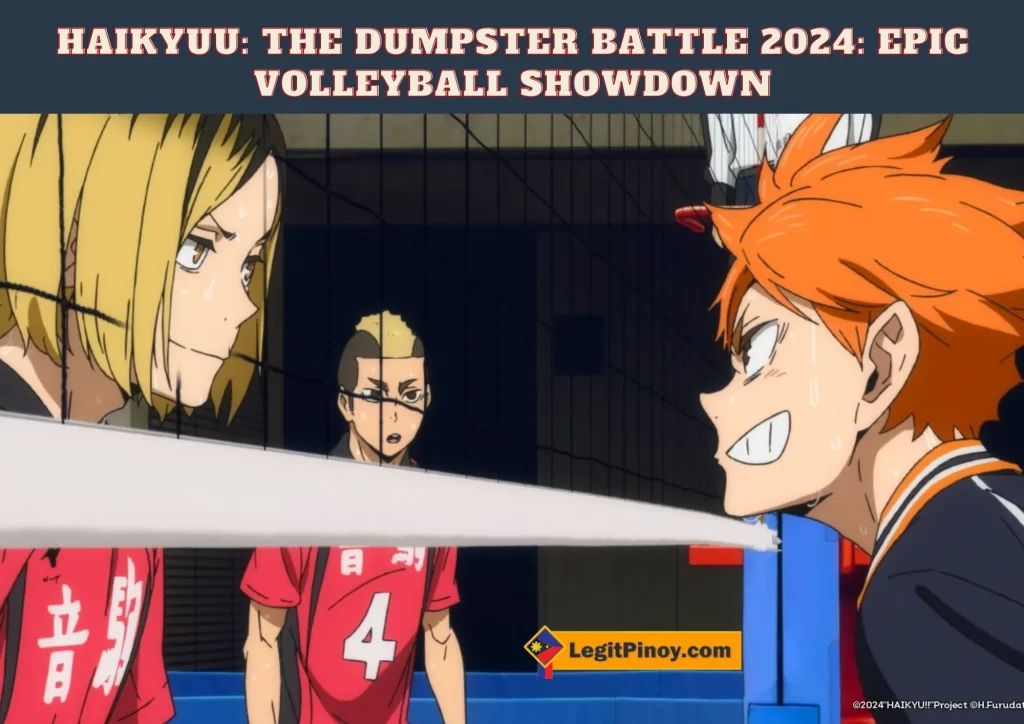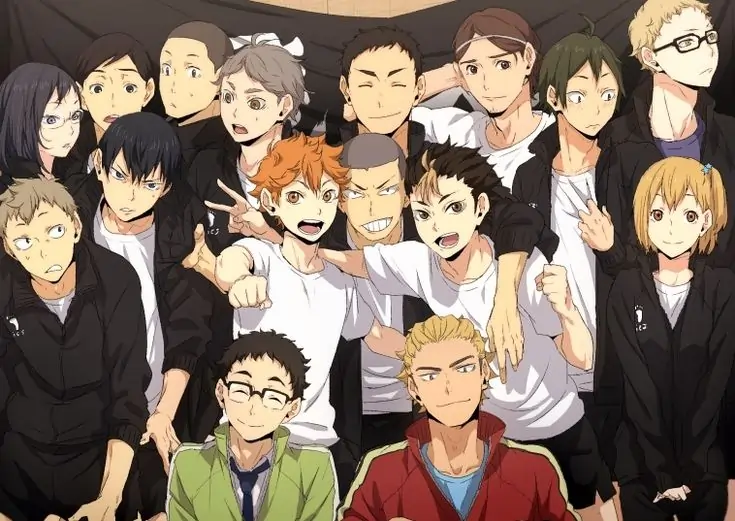Haikyuu: The Dumpster Battle 2024: Epic Volleyball Showdown

Experience the thrill of Haikyuu: The Dumpster Battle 2024. Follow intense volleyball matches and high-stakes rivalries in this epic anime series. Watch Now!
Advertisement

Introduction
“Haikyuu!!” is a popular Japanese manga and anime series written and illustrated by Haruichi Furudate. The series began serialization in Weekly Shōnen Jump in 2012 and concluded in 2020, with the anime adaptation airing from 2014 to 2020. “Haikyuu!!” follows the story of Shoyo Hinata, a short-statured high school student with a passion for volleyball.
Inspired by a famous player known as “The Little Giant,” Hinata is determined to become an exceptional volleyball player despite his height. He joins the Karasuno High School volleyball team, where he meets Tobio Kageyama, a prodigious setter with whom he forms an unlikely but powerful partnership. The series is celebrated for its dynamic characters, intense matches, and realistic portrayal of the sport, making it a beloved title among sports anime and manga fans.
“The Dumpster Battle” refers to the highly anticipated and iconic showdown between two rival high school volleyball teams: Karasuno High and Nekoma High. This rivalry is dubbed “The Dumpster Battle” because Karasuno is associated with crows (often found around dumpsters), and Nekoma is symbolized by cats (which are also often found in similar areas). This match has been built up throughout the series, as both teams strive to prove their prowess on the court. The rivalry is rooted in history, dating back to the days of the teams’ previous generations, particularly the legendary rivalry between the respective coaches, Ukai Sr. from Karasuno and Nekomata from Nekoma.
Origin of the term “Dumpster Battle”
The term “Dumpster Battle” originates from the animal motifs associated with the two rival teams in the “Haikyuu!!” series: Karasuno High and Nekoma High. Karasuno is represented by crows, while Nekoma is symbolized by cats. The name is a playful and metaphorical reference to the behavior of these animals:
- Crows (Karasuno): In many cultures, crows are often found scavenging around dumpsters and urban areas, symbolizing adaptability and resourcefulness. This represents the Karasuno team’s determination and scrappy nature.
- Cats (Nekoma): Cats are also frequently seen near dumpsters, searching for food and territory, embodying agility and cunning. Nekoma’s style of play is characterized by their strategic, defensive prowess and cat-like reflexes.
The “Dumpster Battle” thus encapsulates the spirited rivalry between these two teams, both scrappy and tenacious, drawing on the imagery of crows and cats contesting over the same territory. The term underscores the long-standing, competitive nature of their matches, rooted in both schools’ volleyball traditions and the history shared by their coaches. This colorful nickname adds a layer of thematic depth to their encounters, making the matches between Karasuno and Nekoma even more memorable for fans of the series.
Significant Moments and Milestones in Haikyuu!!
“Haikyuu!!” is packed with pivotal events that drive the story forward and develop its rich cast of characters. Here are some of the most significant moments and milestones in the series:
1. Hinata’s First Volleyball Match (Episode 1)
Shoyo Hinata’s first volleyball match in junior high is against Tobio Kageyama, known as the “King of the Court.” Despite his team’s loss, Hinata’s determination and athleticism leave a strong impression on Kageyama, setting the stage for their future partnership at Karasuno High.
2. Hinata and Kageyama Join Karasuno (Episode 2)
Hinata and Kageyama both enroll at Karasuno High, only to discover they are now teammates. Initially, their clashing personalities create tension, but they gradually learn to work together, forming a powerful setter-spiker duo that becomes the backbone of Karasuno’s offense.
3. Karasuno vs. Nekoma (Practice Match) (Episodes 11-13)
The first practice match between Karasuno and Nekoma rekindles the historic rivalry known as “The Dumpster Battle.” This match is significant for character development, particularly for Hinata, who faces Kenma Kozume, Nekoma’s strategic setter. It emphasizes teamwork and the potential of the newly formed Karasuno squad.
4. Training Camp in Tokyo (Episodes 16-18, Season 2)
Karasuno participates in a joint training camp with several strong teams, including Nekoma, Fukurodani, and others. This camp is crucial for Karasuno’s growth as they face tougher competition and refine their skills. Key moments include Hinata’s improvements in receiving and the team’s overall cohesion.
5. Spring High Preliminary Qualifiers (Season 2)
Karasuno battles through the preliminary rounds of the Spring High tournament. Notable matches include their victories over Johzenji and Wakutani Minami. The series highlights the development of all team members, particularly the synchronization between Hinata and Kageyama.
6. Karasuno vs. Aoba Johsai (Seijo) (Episodes 22-25, Season 2)
One of the most intense and emotionally charged matches is against Aoba Johsai, led by Kageyama’s former teammate, Oikawa Tooru. Karasuno’s narrow victory over Aoba Johsai, achieved through sheer willpower and teamwork, allows them to advance to the finals.
7. Karasuno vs. Shiratorizawa (Season 3)
The match against Shiratorizawa, featuring the formidable ace Ushijima Wakatoshi, is a major turning point for Karasuno. This grueling and epic match showcases the culmination of Karasuno’s hard work, strategy, and determination. Hinata and Kageyama’s quick attack evolves, and Tsukishima Kei steps up as a key player. Karasuno’s victory secures their place in the Spring High Nationals.
8. Nationals Arc (Season 4)
At Nationals, Karasuno faces new challenges and formidable opponents, including the powerhouse team Inarizaki High, led by the Miya twins. This arc highlights Karasuno’s growth and adaptability, as well as the deepening bonds among teammates. Key moments include Hinata’s evolving skills, Kageyama’s leadership, and the team’s unwavering spirit.
9. Karasuno vs. Nekoma at Nationals (Season 4, Episodes 23-25)
The long-awaited rematch between Karasuno and Nekoma takes place at Nationals. This match, steeped in tradition and rivalry, pushes both teams to their limits. Significant moments include Hinata’s development as an all-round player and the intense mental and physical battle between the teams.
10. The Dumpster Battle Conclusion
The rematch between Karasuno and Nekoma at Nationals is the climax of their rivalry. The match is a testament to the growth and resilience of both teams, culminating in a heartfelt and thrilling showdown that celebrates the spirit of competition and sportsmanship.
Milestones
- Hinata’s Journey to Becoming a Well-Rounded Player: Hinata’s development from a spiker relying solely on his athleticism to a more versatile player is a major theme. His journey includes learning new skills like receiving and strategic play.
- Kageyama’s Growth as a Setter and Leader: Kageyama’s transformation from a tyrannical player to a supportive and strategic leader is crucial for Karasuno’s success.
- Team Dynamics and Character Development: The series delves into the personal growth of each team member, including Tsukishima’s newfound passion for volleyball, Nishinoya and Asahi’s redemption arcs, and Daichi’s steadfast leadership.
- Cultural Impact: “Haikyuu!!” has significantly impacted sports anime, inspiring a new generation of volleyball enthusiasts and contributing to the popularity of the sport worldwide.
Overview of Karasuno High School Volleyball Team

Key Players
Shoyo Hinata (Jersey Number 10, Position: Middle Blocker / Wing Spiker)
- Characteristics: Despite his short stature, Hinata is known for his exceptional jumping ability and agility. His passion for volleyball and unwavering determination make him a vital player on the team. He forms a powerful quick attack partnership with Kageyama.
- Role: Hinata’s role evolves from being primarily a spiker to developing all-around skills, including improved receiving and defense.
Tobio Kageyama (Jersey Number 9, Position: Setter)
- Characteristics: Known as the “King of the Court” due to his demanding nature and precise sets, Kageyama is a prodigious setter with exceptional technical skills and court vision. His partnership with Hinata is central to Karasuno’s offensive strategy.
- Role: Kageyama’s growth from a lone genius to a team-oriented player is crucial. He learns to trust his teammates and tailor his sets to maximize their strengths.
Daichi Sawamura (Jersey Number 1, Position: Wing Spiker / Captain)
- Characteristics: Daichi is the dependable captain of the team, known for his strong leadership, consistency, and excellent defensive skills. He keeps the team grounded and focused.
- Role: As the captain, Daichi leads by example, providing stability and moral support to his teammates. His defensive skills and reliable receives are critical during matches.
Koshi Sugawara (Jersey Number 2, Position: Setter / Vice-Captain)
- Characteristics: Sugawara, often called “Suga,” is the team’s vice-captain and a substitute setter. He is strategic, calming, and supportive, often stepping in to provide a different pace and perspective.
- Role: Sugawara’s experience and strategic thinking make him an invaluable backup. He often comes in to change the flow of the game and stabilize the team.
Yu Nishinoya (Jersey Number 4, Position: Libero)
- Characteristics: Nishinoya is the energetic and fearless libero, known for his incredible reflexes, agility, and defensive prowess.
- Role: As the libero, Nishinoya is responsible for receiving serves and digging difficult spikes, anchoring Karasuno’s defense.
Asahi Azumane (Jersey Number 3, Position: Wing Spiker / Ace)
- Characteristics: Asahi is Karasuno’s ace, known for his powerful spikes and height. Despite his initial struggles with self-confidence, he is a key offensive player.
- Role: Asahi’s powerful spikes are crucial in breaking through tough defenses. His journey overcoming self-doubt adds depth to his character and motivates the team.
Ryunosuke Tanaka (Jersey Number 5, Position: Wing Spiker)
- Characteristics: Tanaka is an aggressive and enthusiastic player, known for his fiery spirit and reliability on both offense and defense.
- Role: Tanaka provides a balanced attack and solid defense, often stepping up during crucial moments to rally the team.
Kei Tsukishima (Jersey Number 11, Position: Middle Blocker)
- Characteristics: Tsukishima is a tall, strategic blocker known for his analytical approach to the game and initially indifferent attitude.
- Role: Tsukishima’s blocking skills are vital for Karasuno’s defense. His growth into a passionate and engaged player adds a significant strategic edge to the team.
Tadashi Yamaguchi (Jersey Number 12, Position: Middle Blocker / Pinch Server)
- Characteristics: Yamaguchi starts as an insecure player but grows to specialize in jump float serves, developing confidence and reliability.
- Role: Yamaguchi’s serving skills are used strategically during matches to disrupt the opponent’s rhythm and gain crucial points.
Strategies
- Quick Attacks: The combination of Kageyama’s precise sets and Hinata’s speed is a signature move. This quick attack strategy often catches opponents off guard, leading to effective scoring opportunities.
- Strong Defense: With Nishinoya’s exceptional libero skills and Tsukishima’s strategic blocking, Karasuno focuses heavily on defense. Their ability to dig difficult balls and block powerful spikes is crucial in turning the tide of matches.
- Adaptability: Karasuno is known for its ability to adapt during matches. The team’s practice of changing formations and strategies based on the opponent’s strengths and weaknesses is a key component of their gameplay.
- Serving Pressure: Yamaguchi’s jump float serves are used strategically to disrupt the opponent’s serve receive, creating opportunities for Karasuno to gain points through service aces or forced errors.
Conclusion
“Haikyuu!!” stands as a monumental work in the world of anime and manga, resonating deeply with a global audience through its compelling storytelling, dynamic characters, and realistic portrayal of volleyball. From its debut, the series has captured the hearts of fans with the journey of Shoyo Hinata and the Karasuno High School volleyball team, showcasing their growth, struggles, and triumphs on and off the court.
The significance of “Haikyuu!!” extends beyond its narrative. It has inspired a surge of interest in volleyball, influenced other sports-themed media, and cultivated a vibrant and active fandom. Fans engage passionately through social media, creating and sharing fan art, cosplay, and participating in community events that celebrate the series’ spirit.
Key moments like the “Dumpster Battle” between Karasuno and Nekoma, the intense matches against Aoba Johsai and Shiratorizawa, and the character developments of Hinata, Kageyama, and their teammates have left a lasting impact. These moments not only entertain but also deliver powerful messages about teamwork, resilience, and personal growth.
“Haikyuu!!” is more than just a sports anime; it is a cultural phenomenon that has built a legacy of inspiration and camaraderie. Its ongoing influence, coupled with the enduring enthusiasm of its fanbase, ensures that “Haikyuu!!” will continue to be celebrated and cherished for years to come.
You May Also Like
Advertisement

- Celtics Vs. Heat Game
- Toni Fowler’s pregnancy
- Heatwaves in the Philippines: Impact to Students
- Sarah Duterte
- Mobile Legends New Hero: Chip
- Demon Slayer: Hashira Training Arc
- Asoka inspired makeup: San sanana Trend on Tiktok
- Labor Rights
- Diwata Pares received 1 million pesos and house and lot from Rosmar
- Kaila Estrada’s acting skills is on fire
- David Corenswet as superman
- Mother’s Day 2024
- High Street
- Flirt
- Box Office King and Queen: Alden and Kathryn
- DepEd Plans to Revert to the old Calendar by June 2025
We also recommend the following:
- Peraplay
- Swerte99
- 30Jili
- OtsoCC
- Royal888
- Duke777
- 5Jili
- Okebet168
- Majesty33
- BK8
- Betso88
- Int Games
- Bet86
- Lucky Calico

Jill Lynn is a versatile blogger and content creator who loves writing about a variety of topics. From travel and lifestyle to food and wellness, she shares her experiences and insights with readers around the world. With her authentic voice and engaging storytelling, Jill has built a strong online presence and a supportive community of followers. Her passion for writing and dedication to producing quality content continue to inspire others on their own journeys.
